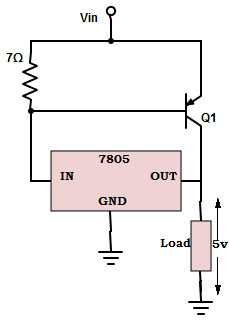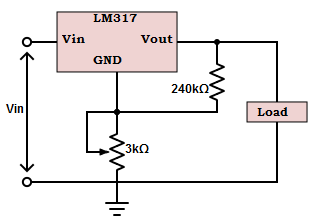11. In the circuit given below, let VEB(ON)=0.8v and ß=16. Calculate the output current coming from 7805 IC and collector current coming from transistor Q1 for a load of 5Ω.

A. IO =111mA, IC= 808mA
B. IO =111mA, IC= 829mA
C. IO =111mA, IC= 881mA
D. IO =111mA, IC= 889mA
12. Calculate the output voltage for the LM314 regulator. The current IADJ is very small in the order of 100µA. (Assume VREF=1.25v)

A. 17.17v
B. 34.25v
C. 89.34v
D. 23.12v
13. Compute the input voltage of the 7805c voltage regulator with a current source that will deliver a 0.725A current to a 65Ω, 10w load. (Assume reference voltage =5v)
A. Vin = 84v
B. Vin = 34v
C. Vin = 54v
D. Vin = 64v
14. Which of the following is not a characteristic of adjustable voltage regulators?
A. Non-versatile
B. Better performance
C. Increased reliability
D. None of the mentioned
15. What is done in switching regulators to minimize their power dissipation during switching?
A. Uses external transistor
B. Uses 1mH choke
C. Uses external transistor and 1mH choke
D. None of the mentioned
16. Fixed voltage regulators and adjustable regulators are often called as
A. Series dissipative regulators
B. Shunt dissipative regulators
C. Stray dissipative regulators
D. All the mentioned
16. Linear series regulators are suited for application with
A. High current
B. Medium current
C. Low current
D. None of the mentioned
17. A series of switching regulators
A. Improves the efficiency of regulators
B. Improves the flexibility of switching
C. Enhance the response of regulators
D. All of the mentioned
18. The switching regulators can operate in
A. Step up
B. Stepdown
C. Polarity inverting
D. All the mentioned
19. What are the conditions to be satisfied by a voltage source for using it in a switching regulator.
1. It must supply the required output power and the losses associated with the switching regulator
2. It must be large enough to supply sufficient dynamic range line and load variations
3. It must be sufficiently high to meet the minimum requirement of the regulator system to be designed
4. It may be required to store energy for a specified amount of time during power failure especially if the system is designed for a computer power supply.
A. 1 and 3
B. 1,2,3 and 4
C. 2,3 and 4
D. 1,3 and 4
20. Which of the following act as a switch in the switching regulator?
A. Rectifiers
B. Diode
C. Transistors
D. Relays
